sensory resources lets them make the most of their natural tendency to
explore. Nicole Weinstein gives some pointers.

Babies and toddlers love to explore different textures. Their sense of touch enables them to develop fundamental knowledge of the attributes of everything they encounter - from the warm embrace of their carer's arms to the knobbly ball they explore with their mouth. They are like little scientists trying out everything that comes their way to feel if it is hard or soft, rough or smooth, or whether it has some other interesting property.
In doing so, they begin to understand whether the toy they are about to squeeze will yield to their grasp or if it will stay rigid and firm when they pick it up. Practitioners can support children's sensory explorations by providing them with a wide variety of natural, visual and tactile resources.
SENSORY EXPLORATIONS
For very young children, everything in the environment is new and to be explored. When they see something, they have the urge to touch it or hold it to their ear or mouth to find out more. This is one of the many ways that young children learn.
Most of what babies find out about through sensory explorations results from a combination of perceptual information in which different modalities often work together; so babies' explorations may involve a combination of modalities such as touch (tactile) and sight (visual), or hearing (auditory) and visual (Siegler et al, 2010).
Ann Langston, director of the consultancy Early Years Matters, says a combination of factors is involved if children are to get the most out of their sensory explorations. 'The more variety we can offer, together with the words and the warm interaction we provide, help children to play and explore and to maintain a curiosity about the world they are trying to make sense of,' she says. 'The most important resource is the caregiver, the attachment figure who supports the child's sensory explorations. These early sensations connected with warm interaction and the sight, sound and touch of their carer expand as the baby becomes capable of more complex co-ordinated explorations when they can hold something to look at for longer or when they stare in wonder at the movements of their own hands or feet.'
Finding out about the world through sensory exploration enhances the infant's ability to make predictions, Ms Langston states. 'This is evident when they respond by watching expectantly to see if a ball will fall or when they turn their head towards a voice they hear. Attending in their play to sights, sounds and sensations eventually leads to learning and remembering, as well as to critical thinking.'
RESOURCES
Whether babies and young children are in or outdoors, there will be a great deal of exploration. Natural elements are often a source of pleasure - for example, water, which seems to soothe and challenge at the same time; or grass, which falls away to the touch yet can be pulled and gathered by a little fist.
Sue Gascoyne, owner of Play To Z (www.playtoz.co.uk), which develops resources specifically designed for their sensory appeal, says, 'Many under-threes experience a plastic-dominated world of eating utensils, changing mats and toys, so the feel of toys is particularly important for introducing a range of interesting textures that will interest and engage young children as well as hardwire their brains.
'Treasure baskets containing materials of different properties - for example, metal, wood, fabric, cardboard, rubber, stone, shell, wicker and pottery - will provide a sensory smorgasbord of textures and properties. For example, smooth and rough, warm and cold, heavy and light, soft and hard, and prickly.'
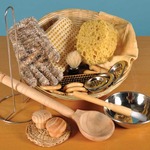 RESOURCES AND ACTIVITIES
RESOURCES AND ACTIVITIES
Here is a list of resources and activities to include in your collection of textures:
- Provide a range of objects of various textures and weights in treasure baskets to excite and encourage babies' interests. Try the Treasure Basket Starter Set (£89.99) from www.reflectionsonlearning.co.uk; the Toddler Basket (£54) from www.heritagetreasurebaskets.co.uk, which contains 35 treasures; the Baby Treasure Basket (£14.99) from Cosy Direct on 01332 370152; the Early Excellenc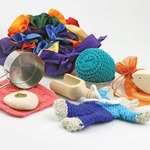 e Treasure Basket of 24 objects (£75) from www.earlyexcellence.com; and Play To Z's EN71-approved Large Value Sensory Collection of 53 sensory-rich items (£205), its Playscope Starter Set of 25 sensory-rich items (£98), or its Treasure Traveller Collection (£28).
e Treasure Basket of 24 objects (£75) from www.earlyexcellence.com; and Play To Z's EN71-approved Large Value Sensory Collection of 53 sensory-rich items (£205), its Playscope Starter Set of 25 sensory-rich items (£98), or its Treasure Traveller Collection (£28).
- Offer collections of different natural or household objects, which can be stored in baskets or drawstring bags and taken out during heuristic play sessions. These can include ribbons, scarves, chains, shells, pom-poms, pine cones, cotton reels, corks, jar lids and large pebbles. Those available on the market include the Heuristic Play Starter Set (£59) from Cosy; the Hide & Seek Collection (£50), Ball and Hoop Collection (£50) and Metal, Wooden and Natural Top Up Sets (£36 each), all from www.playtoz.co.uk ; and the Wonderful Wood Basket (£39.90), Fascinating Foliage Basket (£29.95), Big Naturals Collection (£46.95) and the Wood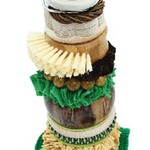 en Reels set (£99.95), all from www.tts-group.co.uk.
en Reels set (£99.95), all from www.tts-group.co.uk.
- Alongside the objects, there should be a large number of containers for children to fill and empty with objects, slot objects into, stack and open and close. For example, household cardboard tubes, boxes, safe rimmed tins, plastic bottles, bags and wallets. The EN71-approved Mini Stacking Hoops (£28) from www.playtoz.co.uk offers an array of interesting textures, from the squidgy, clammy feel of chamois leather and smooth warm touch of wood to the soft velvet and fluffy felt hoops.
- Create giant sensory texture baskets for children to sit inside and add unusual collections of objects or different textures of materials. Try the Low Basket (£79.95), a lined crawl-in treasure basket from Cosy, or create a den or corner of the nursery using a range of textured fabrics such as the Soft Hessian sheet (£10.95), Rainbow Habutae Fabric Set (£17.95) or African Masai Fabric (£17.99), all from Cosy; or the Tactile Fabrics Pack (£34.99) from www.earlyyears.co.uk. Add furnishings such as Easy Feely Cushions (£45.99) from Cosy and Texture Boards (£36.95) from www.tts-group.co.uk.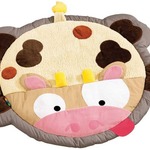
- Texture mats are available for babies. Try the Texture Reflector Mat (£62.50) from Cosy; the Black and White Baby Pod (£74.95), four double-sided Baby Texture Mats (£89.95) and the Baby Texture Blanket (£39.95), all from www.tts-group.co.uk; the Cow Early Learning Mat (£63.60) from www.wesco-eshop.co.uk; the Tactile Quilt (£34.99) from www.earlyyears.co.uk; or the handmade Flower Meadow Mat (£62), which comes with stories, songs and activities, from www.playtoz.co.uk.
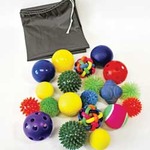 - Collections of balls are popular with young children. Try the Treasure Basket Multi-Sensory Ball Pack (£29.99) from www.reflectionsonlearning.co.uk; the Tactile Ball Collection (£50) from www.playtoz.co.uk; the Multi Sensory Ball Pack (£29.98) from Cosy; or the Feely Ball Nursery Sensory Tub (£162.50) from www.spacekraft.co.uk.
- Collections of balls are popular with young children. Try the Treasure Basket Multi-Sensory Ball Pack (£29.99) from www.reflectionsonlearning.co.uk; the Tactile Ball Collection (£50) from www.playtoz.co.uk; the Multi Sensory Ball Pack (£29.98) from Cosy; or the Feely Ball Nursery Sensory Tub (£162.50) from www.spacekraft.co.uk.
- Explore different textures of malleable and messy materials. Use the set of three Giant Bowls (£8.99), White Circular Tray (£19.95) or the Low Messy Station (£54.99) to explore Jelly Crystals (£13.99), Rainbow Swamp Gel (£11.99), Cellulose Slime Pack (£1.09) or Cornflour (£8.99), all from Cosy. Or try the Activity Bowl (£18) from www.playtoz.co.uk with sand, water, dried rice or gloop.
REFERENCE
Siegler, R, DeLoache, J & Eisenberg, N (2010) How Children Develop: International Edition, Worth, Palgrave MacMillan
ANN LANGSTON RECOMMENDS
'I went to a nursery many years ago where they had a table with a sign that read "Please touch", which was just as well because it was difficult to resist scrunching up the crushed Cellophane, squeezing the squashy balls and shaking the brightly coloured sticks as the colours changed when the oily contents mixed together. Children don't usually need encouragement to explore - it's part of their nature - but enabling adults can support children's explorations by ensuring that risks are assessed and that they enjoy their many journeys of discovery'.









